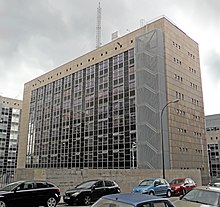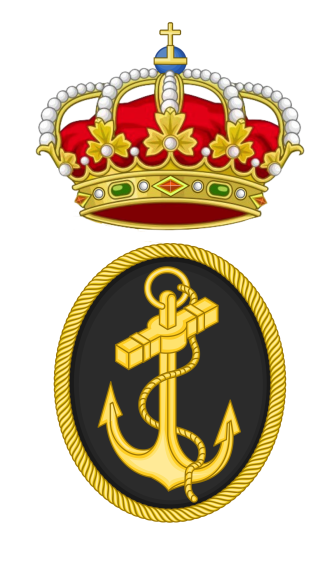
The Spanish Navy or officially, the Armada, is the maritime branch of the Spanish Armed Forces and one of the oldest active naval forces in the world. The Spanish Navy was responsible for a number of major historic achievements in navigation, the most famous being the discovery of America and the first global circumnavigation by Elcano. For several centuries, it played a crucial logistical role in the expansion and consolidation of the Spanish Empire, and defended a vast trade network across the Atlantic Ocean between the Americas and Europe, and the Manila Galleon across the Pacific Ocean between the Philippines and the Americas.

The Álvaro de Bazán class, also known as the F100 class, is a class of Aegis combat system-equipped air defence frigates in service with the Spanish Navy. The vessels were built by Spanish shipbuilder Navantia in Ferrol, with the lead ship of the class named for Admiral Álvaro de Bazán.

Navarra (F85) is the fifth of the six Spanish-built Santa Maria-class frigates of the Spanish Navy, which are based on the American Oliver Hazard Perry-class design. The vessel was constructed by Bazan and launched on 23 October 1992 and commissioned on 27 May 1994. The Santa Maria-class frigates provide anti-submarine and anti-air defence for the Spanish Navy.

Juan Carlos I is a multi-purpose aircraft carrier-landing helicopter dock (LHD) in the Spanish Navy. Similar in role to many aircraft carriers, the amphibious landing ship has a ski jump for STOVL operations, and is equipped with the McDonnell Douglas AV-8B Harrier II attack aircraft. The vessel is named in honour of Juan Carlos I, the former king of Spain.
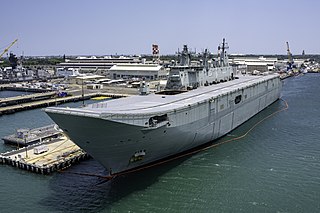
The Canberra class is a ship class of two landing helicopter dock (LHD) ships built for the Royal Australian Navy (RAN). Planning to upgrade the navy's amphibious fleet began in 2000, based on Australian experiences leading the International Force for East Timor peacekeeping operation. With a new climate for growing Australian Navy spending, a desire existed for forward defence capability for landing and supporting troops on Asian territory, that had never existed in Australian history, even with the old Majestic-class light fleet carriers, HMAS Melbourne and HMAS Sydney in the 1970s. In 2004, French company Direction des Constructions Navales (DCN) and Spanish company Navantia were invited to tender proposals, with DCN offering the Mistral-class amphibious assault ship and Navantia proposing the "Buque de Proyección Estratégica" design. The Spanish design was selected in 2007, with Navantia responsible for construction of the ships from the keel to the flight deck, and BAE Systems Australia handling the fabrication of the combat and communications systems. Finally, Siemens (Germany) supplied and fitted the azimuth thrusters.

Fene is a municipality in the province of A Coruña in the autonomous community of Galicia in northwestern Spain. It is located to the northeast of Galicia on the Ria of Ferrol.
ASTANO or Astilleros y Talleres del Noroeste is a shipbuilding company based in Fene, Ferrolterra, Spain, near the city of Ferrol, which flourished during the 1960s and the early 1970s coinciding with the end of the Francisco Franco era and the arrival of democracy. From the late 1980s and early 1990s the possibility of joining the other shipyards of Ferrolterra and from the year 2000 forms an integral part of NAVANTIA formerly IZAR.

Almirante Juan de Borbón (F-102) is the second ship of the new F-100 class of air defence frigates entering service with the Spanish Navy in 2003. She is named for Infante Juan de Borbón, Count of Barcelona, father of the former King of Spain, Juan Carlos I.

The Guaiquerí-class patrol vessels are a class of ocean patrol vessels or POVZEE in Venezuelan Navy service. The lead ship were originally intended to have the pennant F-31 and name of Guaicaipuro but has since been renumbered.

The Meteoro-class offshore patrol vessel, also known as Buque de Acción Marítima (BAM), are new modular offshore patrol vessels of the Spanish Navy adapted to different purposes from a common base, manufactured by Navantia. The BAMs combine high performance with mission versatility, a high commonality with other ships operated by the Spanish Navy. Acquisition and lifecycle costs are reduced.

HMAS Canberra (L02) is the first ship of the Canberra-class landing helicopter dock in service with the Royal Australian Navy (RAN) and is the second largest in the Navy, succeeded by its sister ship HMAS Adelaide (L01). Construction of the ship started in Spain in 2008, with the hull launched by Navantia in 2011. The hull was then transported to Australia in late 2012 for completion by BAE Systems Australia. Canberra was commissioned on 28 November 2014.

HMAS Adelaide (L01) is the second of two Canberra-class landing helicopter dock (LHD) ships of the Royal Australian Navy (RAN) and is the largest naval vessel ever built for Australia. Construction of the ship started at Navantia's Spanish shipyard, with steel-cutting in February 2010. The ship was laid down in February 2011, and launched on 4 July 2012. Delivery to Australia for fitting out at BAE Systems Australia's facilities in Victoria was scheduled for 2013, but did not occur until early 2014. Despite construction delays and predictions, the ship was commissioned in December 2015.

Cantabria (A15) is a replenishment oiler operated by the Spanish Navy. Acquired to provide logistical support for the Spanish fleet, Cantabria was commissioned in 2010. Cantabria is the second-largest naval ship currently operated by the Spanish, behind Juan Carlos I.

Audaz (P-45) is an offshore patrol vessel and the fifth of the Meteoro class created for the Spanish Navy. It is the fourth Navy ship to carry this name. The patrol vessel was built in the Navantia's shipyard in San Fernando.

Furor (P-46) is an offshore patrol vessel and the sixth of the Meteoro class created for the Spanish Navy.
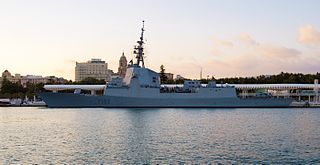
Blas de Lezo (F-103) is a Spanish Navy guided missile frigate of the Álvaro de Bazán class. This is the third ship class of air defense frigates in the Spanish Navy. It was named after the 18th century Spanish Admiral Blas de Lezo. The ship was built by Izar Shipbuilding in Ferrol, Spain and entered into service in 2004.

Ferrol Naval Base also known as the Arsenal of Ferrol is a military base and arsenal of the Spanish Navy located in Ferrol, Spain. It is the main Spanish naval base on the Atlantic.
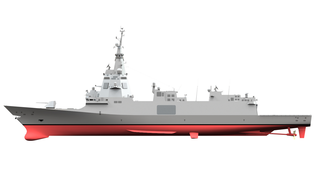
The F110 class, also known as the Bonifaz class, are a multi-purpose, anti-submarine class of Aegis combat system-fitted heavy frigates under construction for the Spanish Navy. The project is being co-developed by the Spanish Ministry of Defence and the state-owned company Navantia. The construction of the first unit started in April 2022. Deliveries are scheduled to start in about 2025.

The Astilleros y Maestranzas de la Armada(English: Navy Shipyards and Armories), better known by the acronym ASMAR, is a Chilean state-owned shipbuilding company with autonomous administration, which provides services to the Chilean Navy, mainly, and also to other domestic and foreign customers. Its predecessor was Arsenales de Marina, created in 1895, until it was restructured and adopted its current name on April 6, 1960.

Naiguatá (GC-23) was a 79.9-metre (262 ft) Guaicamacuto-class patrol boat of the Venezuelan Coast Guard. The vessel was constructed by Navantia in Cádiz, Spain beginning in 2008. On 30 March 2020, the vessel collided with the cruise ship RCGS Resolute in international waters and sank.
